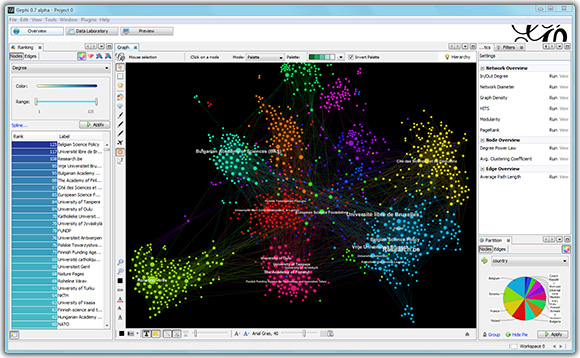Data Visualization
- Sheridan Libraries
- Guides
- Data Visualization
- Network Visualization
Guide for technologies, techniques, and best practices for data visualization.
Contact Me
Introduction to Network Visualization
A network refers to an object composed of elements and relationships or connections between those elements.
Network analysis is a collection of techniques for examining the relationships between entities, and depicting the structure of those relationships. Network analysis spans a number of domains, including social networks, bibliometrics, epidemiology, bioinformatics, complex systems, and text analysis.
Graph theory provides the formal basis for network analysis, across domains, and provides a common language for describing the structure of networks.
Network visualization involves the visualization of the relationships (edges or links) between data elements (nodes).
Network Visualization Software
- Gephi
 Gephi is the leading visualization and exploration software for all kinds of graphs and networks. Gephi is open-source and free.
Gephi is the leading visualization and exploration software for all kinds of graphs and networks. Gephi is open-source and free. - Cytoscape
 Cytoscape is an open source software platform for visualizing complex networks and integrating these with any type of attribute data.
Cytoscape is an open source software platform for visualizing complex networks and integrating these with any type of attribute data. - GraphVis
 Graphviz is open source graph visualization software. It has several main graph layout programs. It also has web and interactive graphical interfaces, and auxiliary tools, libraries, and language bindings.
Graphviz is open source graph visualization software. It has several main graph layout programs. It also has web and interactive graphical interfaces, and auxiliary tools, libraries, and language bindings. - igraph
 An open-source collection of network analysis tools with connectors in R, Python, Mathematica and C/C++.
An open-source collection of network analysis tools with connectors in R, Python, Mathematica and C/C++. - UCINET
 UCINET 6 for Windows is a software package for the analysis of social network data. UCINET comes with the NetDraw network visualization tool.
UCINET 6 for Windows is a software package for the analysis of social network data. UCINET comes with the NetDraw network visualization tool. - SocNetV
 The Social Network Analysis and Visualization Software (SocNetV) is a fee and open-source tool for social network analysis.
The Social Network Analysis and Visualization Software (SocNetV) is a fee and open-source tool for social network analysis. - Pajek
 Analysis and visualization of very large networks on Windows. Pajek is a free alternative to UCINET.
Analysis and visualization of very large networks on Windows. Pajek is a free alternative to UCINET.
Network Visualization and Analysis Programming Libraries
Programming Language |
Network Visualization and Analysis Library |
|---|---|
Python |
NetworkX is a Python package for the creation, manipulation, and study of the structure, dynamics, and functions of complex networks. |
python-igraph is a Python connector to the igraph collection of network analysis tools. |
|
R |
igraph is an R connector to the igraph collection of network analysis tools. |
visNetwork is an R package for interactive network visualization, built on the vis.js Javascript library. |
|
Julia |
JuliaGraphs is an aggregation of all the common packages in Julia for using and studying graphs, including visualization using the GraphPlot and NetworkLayout packages. |
